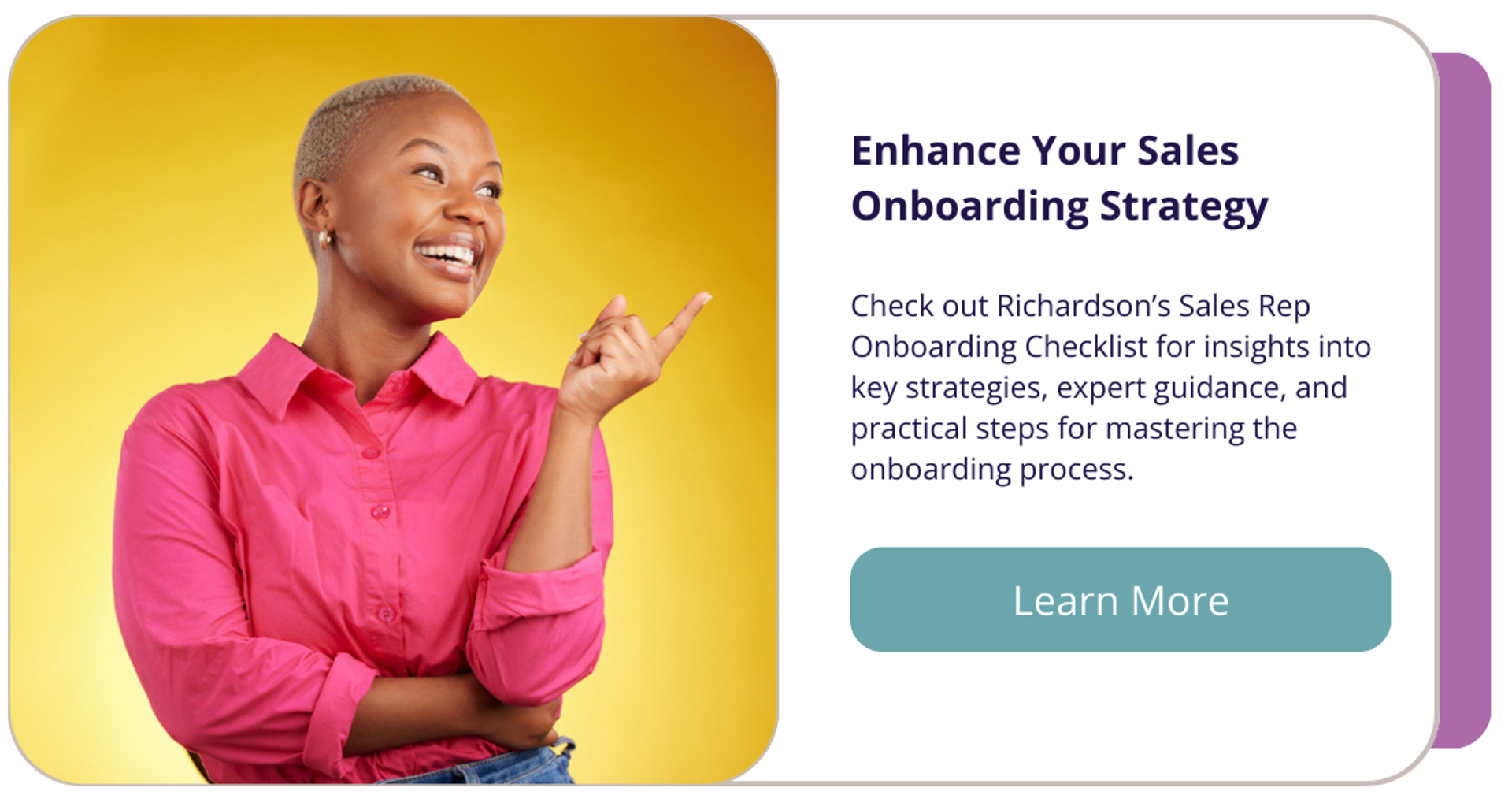Sales Onboarding: A Complete Guide for Onboarding New Sales Professionals
Sales performance improvement

What is Sales Onboarding?
Sales onboarding is a critical process for equipping new sales professionals with the skills they need to be successful in their role, including introducing your company's standards, your approach to selling, and the tools they need to be successful. Onboarding is conducted during the first days, weeks, or months of a new role.
Importance of Having a Structured Plan for Onboarding New Sales Reps
A well-structured sales onboarding plan is critical for new sales professionals as it not only maximizes the value derived from the costs of recruitment but also sets the stage for success.
Replacing an employee can cost between half to double their annual salary, as per Gallup research, making effective onboarding a sound investment.
Improve Time to Productivity
In sales, every single day matters. Unlike other roles within a company, sales representatives face significant pressure to start bringing in revenue as quickly as possible. A structured onboarding plan is more than an introduction to your company; it’s also about acceleration toward productivity. Shortening ramp time, providing the right tools, targeted training, and ongoing support are key. The faster a new rep gets up to speed, the closer they are to their targets. Any delay means falling behind, and in a competitive environment, this can be detrimental.
Increase Engagement, Performance and Commitment
Data from Gallup, collected from over 195,600 U.S. employees, reveals that a robust onboarding approach leads to more engaged employees who consistently outperform their peers, regardless of the industry, company size, or economic conditions. Engagement isn’t a bonus in sales; it's a necessity. Engaged employees are quicker to adapt, more focused on their targets, and aligned with company goals.
8 Sales Onboarding Best Practices and Processes
Sales onboarding plays a pivotal role in driving productivity, especially for sales organizations where time is money. Here are eight key strategies to streamline the process of onboarding new sales reps and ensuring their success:
1. Establish a Culture of Commitment
Sales leaders should consistently convey their financial and professional investment in the success of new hires. By conveying this commitment, they foster a sense of shared goals, enhancing the dedication of sales professionals who understand that the company has dedicated resources for their success.
2. Adopt Omnichannel Learning Solutions
In today's, hybrid work environment, sales reps require a learning approach that fits their diverse needs and schedules. Whether they're working from home, on the road, or in the office, the ability to access learning in bite-sized chunks, precisely when and where they need it, is crucial. An omnichannel approach ensures continuous learning without interrupting the flow of work. It allows them to access content across various devices and platforms enhancing their adaptability and minimizing time away from the market.
3. Shadow Team Members
Sales is about interaction. To get new sales reps quickly acclimated, establish a peer coaching program with a strong emphasis on shadowing. This approach doesn't need to be complicated—it's about learning through observation and interaction.
4. Implement Role-Playing Exercises
Role-playing helps new sales reps to gain confidence and practice specific selling skills in a simulated, yet realistic environment. This method allows them to learn from repetition and experience the pressures of selling in a controlled setting.
5. Develop a Strategy for Skill Sustainment
True skill sustainment goes beyond simple reinforcement—it implies continuous improvement. This skill sustainment strategy should include setting clear expectations and measurable goals through direct, in-person communication. In other words, set the expectation that skill building will continue after the onboarding period.
6. Encourage Early and Regular Engagement
For sales leaders, engaging rales reps as quickly as possible is vital. This interaction should start by clearly defining the vision for the new hire's role within the company. Such clarity allows new sales reps to understand their responsibilities and the expectations placed on them, cultivating a sense of ownership and commitment.
This engagement should not be a one-time event but a continuous process. Regular check-ins and constructive feedback sessions should be part of the onboarding plan, ensuring the new sales reps feel supported and guided. This ongoing dialogue encourages a dynamic learning environment and facilitates quicker acclimation to the company culture and sales processes.
Further, this consistent engagement boosts the new hire's "locus of control"—their belief in their ability to influence outcomes. This confidence, instilled early and nurtured regularly, can be a significant driver of success and satisfaction in their new role.
7. Create a Shared Definition of Success
Sales leaders and new hires need to collaboratively define success. Balancing quantitative goals with more nuanced, qualitative objectives can be challenging, but doing so early sets the foundation for unified efforts toward a common goal.
8. Pace Onboarding by Practicing Balance
Carefully pace the onboarding process by considering the flow and order of introducing various training components. For instance, introducing product training before a new rep understands the customer base can be confusing and counterproductive. Being thoughtful about when and how to present different training aspects ensures a seamless transition and integration into the company's sales force.
Sales Onboarding Goals: The Outcome of the Proper Process
A successful sales onboarding process focuses on three primary goals: fostering the correct mindset, nurturing the appropriate skillset, and familiarizing new hires with the right toolset.
The Right Mindset
The initial objective of onboarding is to instill the right mindset. Understanding the "why" behind the company's sales approach is essential for new sales reps. Once they grasp the rationale behind the go-to-market strategy, they can fully commit and develop the perseverance required for the subsequent steps in the onboarding process.
The Right Skill Set
With the right mindset in place, new sales reps can start acquiring the necessary skills to progress. This phase of onboarding is typically the most intensive, encompassing training in selling methodology, selling capabilities, value proposition, and product differentiators. Effective learning utilizes a multifaceted approach, combining instructor-led facilitation and coaching, digital learning, assessments, learning in the flow of work, and dedicated manager observations and feedback.

The Right Tool Set
Finally, new sales reps must be trained to understand and make use of the two main categories of tools that are vital to their day-to-day work.
The first category involves intuitive sales training tools, such as Richardson’s Accelerate, that focus on ensuring the sales rep comprehends the company's selling methodology and possesses essential selling skills. These kinds of tools often integrate with existing LMSs and provide continuous learning and reinforcement within daily routines. The training here is focused on building the foundational sales approach and the cultivation of selling skills.
The second category is about operational tools that sales reps use every day, with the CRM system being a prominent example. These tools are not related to skills or training but are essential for embedding best practices into the seller’s regular flow of work. Training on how to use these tools is a critical part of onboarding, not because of what the tools inherently do, but because of how vital they are to the daily functioning of a sales rep. Understanding the capabilities and functions of these tools allows the sales rep to perform their job more effectively and align with the company's specific sales processes.
This dual focus ensures that the new sales reps are not only skilled but also fully operational, able to leverage the complete set of tools they will encounter in their new role.
For an example of how the right toolset and CRM integration can assist new sales reps, learn more about Richardson's approach to improving CRM workflows in the video demo below.
Learn More About our CRM-Integrated Sales Workflow Tools
Common Mistakes in the Sales Onboarding Process
Effective onboarding is as much about avoiding mistakes as it is about making the right moves. Sales and Sales Enablement leaders should be mindful of these three common pitfalls.
1. Disrupting the Proper Order of Events
Onboarding is like building a house; everything needs to happen in the correct order. Starting with the basics is crucial, much like laying the foundation before working on the walls and roof.
Avoid bombarding new sales reps with digital tools, printed materials, and in-person training all at once. Instead, introduce each element in a logical sequence, allowing each new piece to build upon the previous one.
2. Information Overload
There's a saying about "drinking from a fire hose" that describes the feeling of information overload. Resist the urge to present all information at once. Let new sales reps absorb one concept before moving on to the next. Ensure they are comfortable with each section or module before introducing new ones.
3. Not Providing a Dedicated Coach
During onboarding, new sales reps will interact with many people, from fellow sellers to department heads and team leaders. To avoid confusion, it's essential to designate a central point of contact or a "home base". The sales leader often fulfills this role effectively, providing a reliable source of answers as new hires navigate their learning journey.
The Three Stages of an Effective Sales Onboarding Plan
A comprehensive sales onboarding plan should unfold in three successive stages: understanding the basics, learning the tools and metrics, and developing advanced skills.
Stage 1: Comprehending the Fundamentals
Initially, new sales reps must grasp three essential components: the sales methodology, the pipeline structure, and the product's unique value proposition.
- Ensure new reps understand the company's sales methodology, its steps, and the rationale behind its use.
- Familiarize them with the sales pipeline, including its stages, how prospects move through these stages, and how messaging varies at each stage.
Teach them to identify and articulate the unique features of your product or service within the context of the customer's business.
Stage 2: Mastering Tools and Metrics
In the second stage, new sales reps need to learn how to utilize the CRM system effectively, understand the communication cadence, and familiarize themselves with the core sales metrics.
Show them how the CRM system supports the sales process, how it aligns with the selling methodology, and how the data they input informs company decisions.
Define the expected communication cadence with prospects and customers, how messaging should evolve throughout the sales process, and the resources available for creating compelling messages.
Explain the key sales metrics, why they are used, how often they are measured, and provide benchmarks and targets for each metric.
Stage 3: Advancing Key Skills
The final stage equips new sales reps with advanced skills, including account planning techniques, negotiation skills, and the ability to sell effectively to C-suite stakeholders.
- Guide them on engaging with senior-level stakeholders, criteria for focusing on specific accounts, and techniques for tracking changes in a customer's business.
- Share negotiation strategies, including how to understand customer values, structure negotiations, and identify tradable items.
- Teach them how to establish credibility quickly with C-suite stakeholders, articulate their value succinctly, and map the solution to the customer's world.
Sales Onboarding Program Checklist
Creating an effective sales onboarding program is much like constructing a sales funnel. Both processes should start with a broad perspective, progressively narrowing down to more detailed and specific information as they advance.
The primary purpose of sales onboarding is to welcome new sales reps into the organization and provide them with the necessary tools, knowledge, and training to succeed. This process can be likened to a journey, beginning with a general introduction to the organization, its culture, and values, before delving into the intricate details of the company's sales methodologies, CRM systems, and unique selling propositions.
Just as a sales funnel filters a wide pool of prospects into a smaller group of qualified leads, an effective onboarding program gradually transitions new sales reps from their initial introduction to a deep understanding of the organization's processes and practices.
As the onboarding progresses, the focus sharpens, evolving from broad organizational insights to the specific skills and knowledge required for the new sales reps to thrive in their roles.
To help you structure an effective sales onboarding program, we've developed a comprehensive checklist. This checklist will guide you through each phase of onboarding, ensuring that new sales reps receive a well-rounded introduction, gradually moving towards highly targeted, role-specific training. This progressive approach helps new hires build confidence, competence, and ultimately, deliver outstanding sales performance.

Bringing it all Together
The onboarding process is a great opportunity to set new sales reps on a trajectory for success. Unfortunately, only 12% of employees strongly believe their companies excel at onboarding, according to Gallup research. This highlights an urgent need for organizations to improve their onboarding strategies, especially in the high-stakes world of sales where time-to-productivity is paramount.
Remember, onboarding is an upfront investment that pays off down the line. By meticulously designing and implementing a robust onboarding program, as outlined in this guide, you can significantly improve the effectiveness of your new sales reps.

Webinar Recording: Accelerating Sales Team Productivity - Critical Elements for Onboarding and Skill Development
Get a fresh perspective on what good onboarding means, and how you can implement an approach that enables your organization to exceed your productivity goals.
DownloadGet industry insights and stay up to date, subscribe to our newsletter.
Joining our community gives you access to weekly thought leadership to help guide your planning for a training initiative, inform your sales strategy, and most importantly, improve your team's performance.






